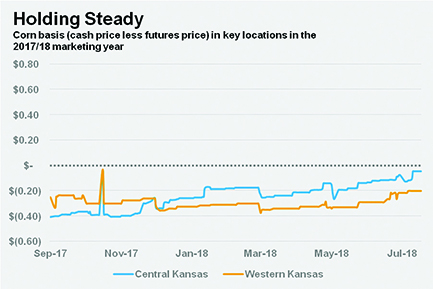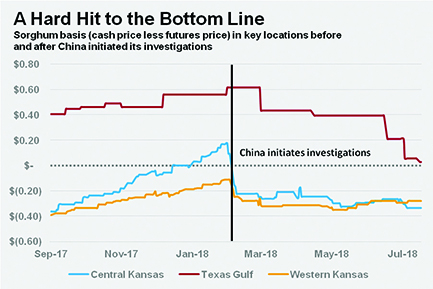
Swipe For More >
Trade Dispute Deals Blow to Sorghum Farmer Profitability
A breakdown of the current economic environment and how trade plays an import role in sorghum demand. The economic pain the China investigations inflicted on U.S. sorghum.
Every dollar counts in the current economic environment. With the U.S. average sorghum price declining from a high of $6.33 per bushel in the 2012/13 marketing year to around $3.20 per bushel today, sorghum farmers cannot afford another blow. Unfortunately, ongoing uncertainty surrounding the trade negotiations with China has already cost sorghum farmers as much as $1.36 per bushel or $92 per acre in lost value and opportunity.
Trade has always been an important component of sorghum demand. NSP was a founding member of the U.S. Grains Council, and sorghum farmers long relied on Mexico as their largest trading partner. In April 2013, trade grew even more important with the entrance of China into the market for U.S. sorghum. Chinese poultry, swine and dairy producers quickly became the crop’s largest end-users, purchasing 75 percent of total production in the 2015/16 marketing year. Mexico and others joined China to import over 90 percent of that year’s crop—a new record in both share of production and total volume exported.
Five years—to the day—after the U.S. Department of Agriculture reported the first purchases of U.S. sorghum by China, the country levied 178.6 percent tariffs based on alleged findings that U.S. farmers had sold sorghum below their cost of production. This halted trade immediately, and the more than 60 million bushels of sorghum already en route to China had to be redirected. Had redirection not occurred, total tariffs would have approached $500 million or about twice as much as sorghum farmers have made from the Chinese market since 2013. The 178.6 percent tariffs were dropped in May, but the 25 percent tariffs levied in retaliation for the Section 301 intellectual property investigation remain in effect.
As a result of the ongoing uncertainty, U.S. sorghum farmers continue to experience severe economic pain. Since the original investigation that led to the 178.6 percent tariffs was initiated, prices paid to sorghum farmers have fallen precipitously. This decline has lowered the average sorghum basis across the U.S. by up to $0.74 per bushel or $50 per acre. Furthermore, corn futures have declined by as much as $0.62 per bushel or $42 per acre. Together, the total impact is as high as $1.36 per bushel or $92 per acre.
The average sorghum farmer raises crops on less than 1,300 acres, of which approximately 600 are planted to sorghum each year. Accordingly, the trade war has cost each farmer as much as $55,000 in lost opportunity. Although some are also employed off the farm, some have cattle or other value-added enterprises, and some have spouses that work off the farm, sorghum is the primary source of income for thousands of families across the Sorghum Belt. For these families, losing $55,000 could have disastrous consequences.
Sorghum farmers are keenly aware of the inequities currently working against U.S. industries engaging in international competition. Their industry is vibrant today in large part because of the opportunities provided by exports over the last six decades, and most believe other industries should have the same opportunities. However, U.S. agriculture is comprised of family farmers who cannot stand to lose markets. With this in mind, NSP will continue to advocate vocally for fair trade practices while urging lawmakers to stand by farmers during these discussions.



